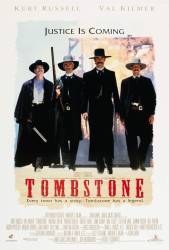Continuity mistake: In the beginning, when Doc Holiday is playing poker with Ed Bailey, they tell Doc to drop his cards. He does so, and reveals a poker of queens. In a fury, Ed Bailey stands up pushing the table. When he does this, you see Doc's cup with liquor in it fall and roll off the table. Doc even watches it fall off the table onto the floor. When they show Doc again, the cup is right there where it was before, in perfect stance. Doc even drinks the rest of the liquor inside it, a little bit later on in the scene. (00:11:55)
Continuity mistake: When Curly Bill is shooting up the town while drunk, he fires about 10 more rounds than his six shooter can hold without reloading (so too many shots even if he had a second gun), and still has a round remaining when he shoots Marshal Fred White. In the 1880 court hearing held after Marshal White's death, Curly Bill still had 5 rounds remaining in his pistol.
Continuity mistake: Just prior to the actual gunfight scene as both sides have their hands on their guns waiting for something to happen, Frank McLaury is first shown wearing his hat. A few moments later he is shown by himself, looking to his right, without the hat. Then again, moments later, the hat reappears.
Continuity mistake: In the first scene when the priest, bride, and groom, etc. come out of the church you can see the priest putting on his hat in two different angles.
Continuity mistake: During the fight at the O.K Corral Doc empties one of his guns into the man with the blue shirt on, then the man starts shooting through the window and Wyatt shouts "Doc, behind us." Doc Holiday immediately empties both his guns into the building without time to reload one.
Continuity mistake: When Doc and Kate are leaving the saloon after he stabbed Ed Bailey, as they stand in the doorway facing the people In the saloon, the light outside shows bright sun with shadows from the buildings, indicating it is mid to late afternoon. When they step outside, there is no bright sunlight and the entire street is in dusky shadow.
Continuity mistake: In the scene where McMasters is looking through his eyeglass and telling Wyatt how many cowboys there are, there's a shot of Doc coughing with a bloody rag up to his mouth. The camera goes back to Wyatt, and when it goes back to Doc, there is blood dripping out of his mouth and all over his bottom lip and chin. In the very next shot when Doc falls off his horse, about two seconds later, his mouth and chin are completely clean.
Continuity mistake: During the gunfight between Johnny Ringo and Doc Holliday, when Ringo falls against the tree, he's wearing a hat. After that, the hat is nowhere to be seen.
Continuity mistake: After shooting up the wedding near the start, they are sitting at the table eating the feast. As the camera shows Curly Bill's plate the food on it keeps changing.
Continuity mistake: During the fight at the OK corral, Doc Holiday has a double barrel shotgun but he shoots it three times, once in the air to spook the horse, once again to shoot the guy behind the horse, then the scene changes and he shoots another guy with the same gun without reloading.
Suggested correction: This is already explained in corrections. The "third shot" is the same as the second shot from a different angle. The mistake is that he changes how he shoots. However, the same guy is shot - and falls dead from each angle.
I don't buy the explanation. What would be the point of the filmmaker doing that when it's not done elsewhere in the movie, and why would the killing of the guy Doc shot be important enough to warrant a shot of it from two angles when none of the others were? No sale; still an error.
Continuity mistake: The scene where Ed says "there's three of them over there" referring to the Cowboys, but when the shot is shown there's actually four Cowboys.





